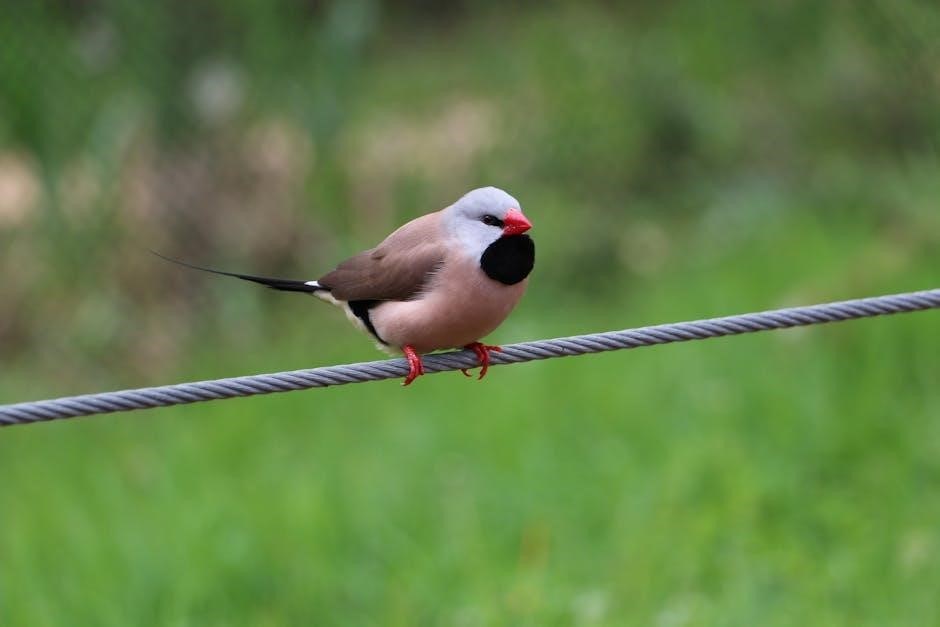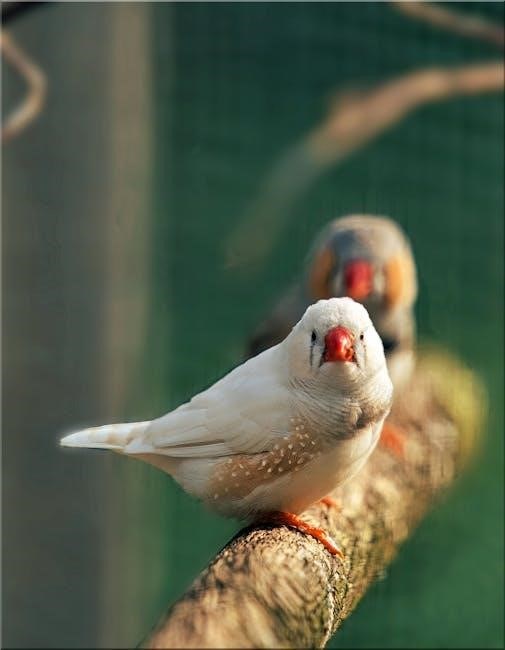This hands-on activity simulates natural selection, allowing students to explore how different beak traits affect survival and reproduction, mirroring Darwin’s groundbreaking studies on finches.
1.1 Overview of the Lab
The Beaks of Finches Lab is an interactive simulation that demonstrates natural selection and adaptation. Students use tools representing different finch beaks to compete for seeds, mimicking ecological pressures. The activity highlights how specific traits, like beak shape and size, influence survival and reproductive success. By analyzing data from the simulation, participants gain insights into evolutionary principles and how environmental changes drive species adaptation. This hands-on approach makes complex biological concepts accessible and engaging for learners.
1.2 Purpose and Significance
The Beaks of Finches Lab aims to educate students on natural selection by simulating how environmental pressures influence survival and reproduction. Its significance lies in providing a hands-on understanding of adaptation, where specific traits, like beak shape, determine success. This lab fosters critical thinking about evolutionary principles and their real-world applications, making it a valuable educational tool for exploring biodiversity and ecological interactions.
1.3 Relevance to Evolutionary Biology

The Beaks of Finches Lab is a cornerstone in teaching evolutionary biology, as it directly demonstrates natural selection and adaptation. By simulating how beak traits influence survival and reproduction, the lab highlights the role of environmental pressures in shaping species. This hands-on approach bridges theory and observation, allowing students to witness how traits like beak shape can drive speciation and biodiversity, making it a powerful tool for understanding core evolutionary mechanisms.
Materials Required for the Lab
Various beak tools (e.g., tweezers, pliers, clips, chopsticks), seeds of different sizes, paper plates, data collection sheets, and timers are essential for simulating finch foraging behaviors.
2.1 List of Materials
The lab requires various beak tools such as tweezers, pliers, clips, and chopsticks to simulate different finch beak types. Seeds of varying sizes are used as food sources. Paper plates or containers are provided for seed distribution. Data collection sheets and pens are essential for recording results. Timers are used to simulate foraging time constraints. Additional materials may include rulers for measuring beak tools or seeds, ensuring accurate data collection and analysis throughout the simulation.
2.2 Tools and Their Representations
Tweezers represent small, precise beaks, ideal for picking tiny seeds. Pliers mimic large, robust beaks, suited for crushing tough seeds. Clips symbolize medium-sized beaks, adaptable for various seed types. Chopsticks may represent specialized beaks, challenging to use but efficient for specific seeds. Each tool’s design reflects real-world beak adaptations, allowing students to observe how beak morphology influences feeding success and survival in different environmental scenarios, aligning with evolutionary principles observed in finch populations.

Procedure of the Beaks of Finches Lab
Students simulate natural selection by competing to collect seeds using assigned tools, representing different beak types. The process involves setup, seed collection, and data analysis to observe survival outcomes.
3.1 Setup and Initialization
The lab begins with preparing materials, including seeds, beak tools (e.g., tweezers, pliers), containers, and data sheets. Students are divided into groups, each assigned a specific beak tool. The environment is set up with seed-filled containers, simulating natural foraging conditions. Before starting, instructors review the objective: to collect the most seeds using their assigned beak tool. This step ensures everyone understands the rules and their roles, setting the stage for simulating natural selection.
3.2 Conducting the Simulation
Students are provided with beak tools and seeds, simulating foraging environments. Each group uses their assigned tool to collect seeds within a set time. The number of seeds gathered is recorded, reflecting the tool’s efficiency. This step mimics natural selection, where finches with advantageous beak traits thrive. The simulation demonstrates how environmental pressures influence survival and reproduction, aligning with evolutionary principles observed in Darwin’s finches. This hands-on approach helps students visualize and understand the adaptive advantages of different beak shapes and sizes;
3.3 Data Collection and Analysis
After the simulation, students record the number of seeds collected by each beak type. Data is organized into charts or graphs to compare efficiency. Analysis involves identifying which beak traits (e.g., size, shape) correlated with higher seed collection. This step highlights how environmental pressures influence adaptation. Students draw conclusions about natural selection’s role in shaping beak diversity, aligning with the lab’s evolutionary biology focus. The answer key provides guidance for interpreting and presenting findings effectively.

Answer Key to Common Questions
This section provides detailed answers to frequently asked questions, ensuring clarity on concepts like natural selection, beak adaptations, and data interpretation, enhancing overall understanding of the lab.
4.1 Predicting Beak Success
Predicting beak success involves analyzing how beak traits like size, shape, and strength influence seed collection efficiency. Tweezers often excel with small seeds due to precision, while pliers struggle with larger ones. Environmental factors and competition also affect outcomes. This section provides insights into how different beak tools perform under various conditions, helping students understand adaptation and natural selection. By evaluating tool effectiveness, students can forecast which beaks are most likely to thrive in specific scenarios, aligning with evolutionary principles observed in finches.

4.2 Explaining Lab Results
Lab results demonstrate how beak traits influence seed collection efficiency. Tools with precise tips excel at gathering small seeds, while larger tools struggle. This reflects natural selection, where traits conferring advantages are favored. Data shows variation in success, aligning with evolutionary principles. Results highlight how environmental pressures shape adaptation, mirroring Darwin’s observations on finches. By analyzing outcomes, students connect beak morphology to survival, reinforcing concepts of competition and selective advantage. This hands-on approach clarifies complex evolutionary mechanisms in an engaging manner.
4.3 Heritability of Beak Traits
Heritability of beak traits is evident through parent-offspring correlations, showing that beak size and shape are genetically determined. Larger beaks are often inherited from parents with similar traits, while environmental factors like food availability influence their development. This genetic variation allows natural selection to act on beak morphology, driving adaptation. The lab highlights how heritable traits contribute to evolutionary changes, aligning with Darwin’s observations on the Galapagos finches. Understanding heritability clarifies the role of genetics in shaping species-specific characteristics over generations.

Adaptation and Natural Selection
This lab demonstrates how environmental pressures drive adaptation, with beak traits influencing survival. The struggle for resources mimics natural selection, showing how species evolve over generations.
5.1 Demonstrating Natural Selection
The Beaks of Finches lab vividly demonstrates natural selection by simulating environmental pressures. Students use tools representing different beak types to collect seeds, mimicking how finches adapt to food availability.
Heritable traits, like beak shape and size, influence survival and reproductive success; This hands-on activity illustrates how environmental challenges drive evolutionary changes, aligning with Darwin’s observations of finch diversity in the Galapagos.
By observing which beak tools succeed, students grasp how natural selection favors traits that enhance survival, leading to adaptation over generations. This practical approach bridges theory with real-world biological processes.
5.2 Role of Beak Adaptation
Beak adaptation plays a crucial role in determining a finch’s ability to survive and reproduce. Specific beak shapes and sizes are suited to particular food sources, such as seeds or insects, reducing competition between species. This specialization, shaped by natural selection, ensures that finches with advantageous traits thrive in their environment. The lab demonstrates how environmental pressures drive the evolution of beak morphology, highlighting its significance in evolutionary biology and species diversity.

Species-Specific Beak Types
Different finch species exhibit unique beak shapes and sizes, adapted to their specific diets, such as large, thick beaks for tough seeds or smaller, pointed beaks for insects.
6.1 Large Ground Finch
The Large Ground Finch has a robust, thick beak adapted for cracking tough seeds, reflecting its diet rich in plant material. This beak structure allows efficient processing of hard seed casings, ensuring survival in environments where seeds are a primary food source. In lab simulations, tools mimicking this beak type, such as pliers, demonstrate high success in gathering larger, tougher seeds, illustrating evolutionary adaptation to specific ecological niches.
6.2 Small Tree Finch
The Small Tree Finch has a smaller, more pointed beak, ideal for eating insects and smaller seeds. This adaptation allows it to exploit a different food source than the Large Ground Finch, reducing competition. In lab simulations, tools like tweezers effectively mimic this beak, demonstrating success in picking small seeds. This specialization highlights how varied beak shapes enable finches to occupy distinct ecological roles, supporting evolutionary principles observed in the wild.

Predicting Beak Success in Different Scenarios
This section explores how beak traits influence survival in varying environments. Simulations predict which beak types thrive with specific seed sizes, teaching evolutionary adaptation concepts.
7.1 Small Seeds and Beak Types
When predicting beak success with small seeds, smaller, more precise beaks (e.g., tweezers) are most effective. Their ability to grasp tiny seeds efficiently demonstrates natural selection, as birds with such traits are more likely to survive and reproduce, passing on their advantageous beak characteristics. This simulation highlights how specific environmental pressures, like seed size, drive evolutionary adaptations in finch populations over time.
7.2 Larger Seeds and Beak Adaptations
Larger seeds favor finches with robust, thicker beaks, such as the Large Ground Finch, enabling efficient cracking and retrieval. This adaptation exemplifies natural selection, where environmental changes (e.g., seed size increase) advantage certain traits, ensuring survival and reproductive success. This scenario underscores how specific beak morphologies evolve to match available food resources, aligning with Darwin’s observations on the Galapagos Islands.

Data Analysis and Interpretation
Analyze seed collection efficiency to evaluate how beak traits influence survival. Compare data across groups to identify trends in adaptation, linking results to natural selection principles.
8.1 Interpreting Seed Collection Data
Seed collection data reveals how different beak tools perform in gathering seeds. Smaller, precise tools like tweezers often collect more small seeds, while larger tools struggle. This demonstrates adaptation advantages.
Compare results across groups to identify patterns in seed collection efficiency. Tools mimicking specialized beaks, such as those for large or slippery seeds, show varying success, reflecting natural selection pressures in real finch populations.
8.2 Drawing Conclusions from Results
Analyze the seed collection data to determine which beak types were most successful in different scenarios. Conclude that specific traits, such as precision or strength, provide adaptive advantages, aligning with natural selection principles.
Discuss how environmental pressures influence beak evolution, as evidenced by the simulation. Emphasize the role of heritable traits in survival and reproduction, reinforcing the concept of adaptation driving evolutionary changes in finch populations over time.
Impact of Environmental Changes
Environmental changes, such as shifts in seed size, create selection pressures favoring specific beak traits, leading to evolutionary adaptations and determining survival success in finch populations.
9.1 Effects on Finch Populations
Environmental changes, such as shifts in seed availability or size, significantly impact finch populations by favoring specific beak traits. Larger seeds may advantage birds with stronger, thicker beaks, while smaller seeds favor precise, smaller beaks. These changes alter survival rates and reproductive success, driving evolutionary shifts. Additionally, environmental stressors can increase competition, leading to niche specialization or migration, further shaping population dynamics and emphasizing natural selection’s role in adaptation. Such pressures highlight the delicate balance between beak morphology and ecological demands.
9.2 Migration and Competition
Migration of finches to new habitats introduces competition for resources, altering population dynamics. Incoming species with specialized beaks may outcompete natives for specific food sources, leading to niche specialization or local extinction. This competition drives evolutionary pressures, as finches must adapt to secure resources. Over time, such interactions shape species diversity, illustrating how migration and competition act as key drivers of ecological and evolutionary change in finch populations, emphasizing survival of the fittest principles.
Beak Morphology and Food Sources
The shape and structure of finches’ beaks determine their ability to exploit specific food sources, with specialized beaks adapting to efficiently gather and process seeds, insects, or nectar.
10.1 Animal vs. Plant Food Sources
Finches with specialized beaks for plant-based food, like seeds, have stronger, thicker beaks for crushing. In contrast, those adapted for animal-based food, such as insects, have smaller, more precise beaks for grasping; This adaptation ensures survival by aligning beak structure with food availability, demonstrating evolutionary specialization based on dietary needs.
10.2 Beak Specialization
Beak specialization in finches is a prime example of adaptive evolution, where specific beak shapes and sizes are suited to particular food sources. Large, thick beaks excel at cracking tough seeds, while smaller, pointed beaks are ideal for catching insects. This specialization enhances survival and reproductive success, as finches with beaks adapted to their primary food source are more efficient foragers. Beak morphology directly reflects environmental pressures, demonstrating how natural selection drives anatomical adaptations to optimize resource acquisition and utilization.
Lab Modifications for Different Settings
The Beaks of Finches Lab can be adapted for virtual or limited-resource settings by using digital simulations or alternative tools, ensuring accessibility while maintaining educational value.
11.1 Virtual Lab Adaptations
The Beaks of Finches Lab can be adapted into a virtual format using digital simulations, where students interact with virtual beak tools and seeds. This setup allows for remote learning while maintaining the core educational objectives. Virtual labs provide flexibility, enabling students to experiment with different beak types and environmental conditions in a controlled digital environment. This adaptation ensures accessibility for students without physical materials, making the learning experience inclusive and engaging. The virtual format also offers opportunities for data analysis and collaborative discussions, fostering a deeper understanding of natural selection principles.
11.2 Alternative Tools and Materials
Alternative tools such as tweezers, chopsticks, and small tongs can replace traditional beak models, offering similar functionality. Household items like spoons, forks, and even small toy beaks can also be used. Seeds of varying sizes can be substituted with beads, rice, or small pebbles to simulate different food sources. These alternatives maintain the lab’s educational value while providing flexibility for resource-limited settings, ensuring students can still explore natural selection concepts effectively.

The Beaks of Finches lab successfully demonstrates natural selection, showing how beak traits influence survival and reproduction. It aligns with Darwin’s observations, emphasizing adaptation’s role in evolution.
12.1 Summary of Key Concepts
The Beaks of Finches lab is an engaging simulation that explores natural selection through beak adaptation. Students use tools to mimic finch beaks, collecting seeds to demonstrate survival challenges. The lab highlights how specific traits, like beak shape and size, influence success in different environments. It emphasizes the role of heritable traits, environmental pressures, and competition in driving evolutionary changes. By linking beak morphology to food acquisition, the activity provides a hands-on understanding of adaptation and its impact on species survival, aligning with core evolutionary biology principles.
12.2 Importance of the Lab in Education
The Beaks of Finches lab is a cornerstone in teaching evolutionary biology, offering an interactive way to grasp natural selection. By simulating real-world scenarios, it engages students in hands-on learning, fostering critical thinking and teamwork. The lab’s emphasis on data analysis and interpretation prepares students for scientific inquiry, aligning with educational standards and proving invaluable for developing a deep understanding of adaptation and biodiversity.